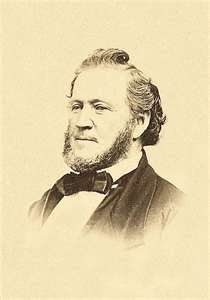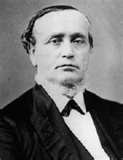Erastus Snow, the second of my "Hard Men," wasn't hard in the same sense that Daniel W. Jones was. He didn't ever lead a 'rough and rowdy' existence. In fact he was the picture of scholarly refinement. Like his sister Eliza, who is famous for her poems and colorful, romanticised accounts of church history, he had a way with words. And like Eliza's, his accounts have been edited by family members for clarity at times.
Erastus was closely associated with both Joseph Smith and Brigham Young. He was a leader of men and organizer of movements. A man who obeyed, and lead. A hard worker and cool-headed in an emergency, he was often put in charge of exacting tasks: opening the mission in Scandinavia, translating the Book of Mormon into Danish, founding colonies in three different, inhospitable places. He survived the Mormon persecutions--all the way from Kirtland to Nauvoo.
He was a well-written, articulate man. Made the best of things, tried not to complain. Deliberate, cool-headed, and analytical, he nevertheless believed deeply in Joseph Smith and Brigham Young as prophets of god. He was very spiritual, exercized his priesthood and paid attention to his family, large as it was.
Erastus loved his family. There were two wives and three children at the time of the crossing to the Salt Lake Valley; Minerva and Artimesia, and Erastus was 28 at the time. At the time of his death, he had at least 4 wives and 36 children.
He was interested in people. He connected especially with spirituality and spiritual experiences of those around him, but he was also interested in science. The Snows were, as those who study Mormon history know, a scholarly family. Eliza was a prolific reader and writer and was later dubbed the "poetess of zion," and Lorenzo, who would become the fifth presiden of the church, was described as "bookish," pursuing education even to the first year of college, which was very uncommon for someone of the farming class. And then there was Zerubabbel. In addition to scholarly pursuits, the family had a tradition of eccentric names, a tradition that runs common in the LDS faith and continues even today. (My new neighbor's first name is Daedree. Pronounced kind of like daydream. I try hard not to call her that by accident.) (And I think there is more than one "LaVerle" in my ward.)
Anyway, Erastus's fascination with humanity had a kind of anthropologic bent. He was very interested in people, and remembered details about everyone he met. And he was fascinated by the Indians. A few accounts from his writings:
"....As soon as they saw our flag they began to cross the river towards us. We took the precaution to stake down our horses and admitted at first only the chief to our camp, but afterward the whole of them. They had their squaws with them and camped about half a mile from us, and visited us again in the morning. They were all dressed in their richest costumes. Some had fur caps and cloth coats, and others had cloth pants and shirts, and the rest were neatly dressed in skins ornamented with beads, feathers, paint, etc., and they were by all odds the cleanest and best appearing Indians we have seen west of the Missouri river. Some of the brethren traded horses with them and bought some peltry, moccasins and other trinkets, and they crossed the river apparently in high glee, and we pursued our journey." From The Diary of Erastsus Snow, edited by his son, Moroni.
And another:
"This is the country of the Snake Indians, some of whom were at the fort. They bear a good reputation among the mountaineers for honesty and integrity. We traded some with the traders at the fort, and with the French and Indians that were camped near there, but we found that their skins and peltry were quite as high as they were in the states, though they allowed us liberal prices for the commodities we had to exchange." (Diary of Erastus Snow, linked above).
You see here that Snow's attitude toward the Indians was an observant, somewhat detached one... interested in how they were different. Perhaps a little condescending at times.
Another passage from his diary:
"During this week the Ute and Shoshone Indians visited our camp in small parties, almost daily, and traded some horses for guns and skins for clothing, etc. They seemed much pleased at our settling here. While here, one of the Utes stole a horse from the Shoshones and was pursued up the valley by the latter and killed, and his comrade and their horses and the victors returned to our camp with the stolen property.
The following Sunday, August 1st, a resolution was adopted in camp to trade no more with the Indians except at their own encampment, and hold out no inducements to their visiting our camp."
And,
"Sunday morning, October 2, while the camp was starting, a high-spirited Spanish mare which I had purchased of Mr. Racheau unhorsed her rider and at the top of her speed, which was like the flight of a hare, pursued an Indian hunting party that was at that time crossing the bottoms some miles distant towards the bluffs, and although I pursued upon my windiest horse I had a ride of about fifteen miles before I could catch her again. This unlucky circumstance threw me into the midst of what was to me quite a romantic scene—a regular Indian buffalo hunt. When the party arrived in the vicinity of some scattering herds they separated into parties of two and three and took their stations upon tops of buttes or eminences in the prairie in all directions for several miles, so that they could see the direction the herd was taking in the flight. Then two Indians started the herd and pursued in the rear while others were intercepting their retreat and, selecting the fattest cows, let fly their arrows (for they use no firearms in this chase) which seldom failed to do execution; and if the first was not sufficient, the second and third arrow quickly followed, and once wounded became the sole target for the Indian’s arrows until the victim fell. Turn which way they would the herd was sure to be attacked by a fresh party of horsemen who in turn would strew the ground with the slain. When the herd had thus run the gauntlet for some four or five miles and the chase was abandoned, the Indians could be seen in all directions dressing their game. I passed one who had been unhorsed and broken his arm in the chase and his squaw was splintering it up. An old Indian presented me with a couple of tongues which with them is the choicest part of the buffalo, and I returned to camp gratified by the scene I had witnessed and scarcely regretted the chase I had for my mare."
Erastus's account of his dealing with the Indians paints a sort of black-and-white picture. There were, to him, "good indians," childlike, willing to be peacable and taught, and "bad indians," who stirred up trouble, were "bloodthirsty," stole things. And often he excuses these "bad" indians, noting that likely they'd been fed lies about the Mormon settlers by preceding companies, or were being "stirred up" by someone against the church.
One more passage, I thought, was particularly revealing. This comes from an address Erastus Snow gave at a conference in Logan, six years before his death. The address was all about the Indians and how the Mormon settlers had influnced them.
"If the Spirit gives me liberty I will pursue the train of thought that has passed through my mind while Brother Richards has been speaking upon
the spirit that has gone abroad upon the remnants of the house of Israel who occupy this land, the American Indians whom we understand to be the descendants of the Nephites, the Lamanites, the Lemuelites and the Ishmaelites who formerly possessed this land, whose fathers we have an account of in the Book of Mormon....we have chastised them when it became necessary to do so, not in malice nor revenge, but as a father would chastise his wayward child, and then as soon as possible pour into their wounds the oil and the wine to heal them up again—those, I say, who are best acquainted with our labors in this direction will best appreciate the results."
And there is the clincher. Right there. Why did Erastus Snow see the Indians as people? They were descendents of the people in the Book of Mormon. His feeling, his "mission" among the Indians, had very much to do with this, and with the desire to help fulfill the prophecy Joseph Smith made at one time about the Lamanites "blossoming as a rose."
Nowadays, such an attitude would of course meet with resistance and be called prejudice. But you have to give Snow props for how his attitude diverged hugely from the attitude of the times. And for his own feelings... he really loved people. And to him, Indians were people...on the level of children, which could seen to be rather condescending, but you have to remember that he was a product of his time. He did see them people, not animals or savages as the majority of settlers and emigrants at the time seemed to believe.
As I read and looked for clues in these histories and accounts of what sort of man Erastus was, I was struck, over and over, by his complete acceptance of everything Joseph Smith or Brigham Young, or any other prophet, had to say. He loved the presidents of the church, and strove to emulate them. You might go so far as to say he adopted a great deal of their ideas, and even persona. In fact, here is an interesting phenomenon. Let me know if you see it... maybe it's just me...
Erastus Snow
Brigham Young
Erastus Snow
Brigham Young
Erastus Snow
I think Erastus saw himself as an extension of the Prophet, and of the church. There are a few references to him in histories as a "prophet" or "prophetic."
Because of who Erastus was--how spirituality was such a focus of his life, how he felt so devoted to the prophets and the LDS gospel, It is possible that Erastus Snow's views of the Indians could be said to echo, or even duplicate those of the church at the time.






1 comment:
At least the examples of Snow family names here had precedent in their scholarly eccentricity than compared to most Mormon corridor mishmashes.
I really enjoyed your pictorial comparison of Brigham Young and Erastus Snow :) Dates on the photos would help to confirm a plausible trend.
Post a Comment